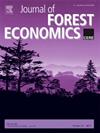基于Faustmann模型的碳经济不确定性研究
IF 0.7
4区 农林科学
Q3 ECONOMICS
引用次数: 3
摘要
森林增长预测用于建立对管理决策未来经济表现的预期。Faustmann土地期望值(LEV)是林业中广泛使用的一个标准,用于评估决策参数的多样性,如轮作年限和疏伐制度。大多数预测以及因此产生的预期都是基于时代知识,假设气候处于稳定状态,并采用确定性的森林生长方法。然而,未来几十年,气候可能会发生不同程度的变化,导致森林增长和碳预算充满活力和不确定性。此外,林业中的碳经济,被定义为原位固碳的机会成本,很难使用经验模型进行分析,因此需要基于过程的森林生物量生产模型。基于过程的模型包括许多参数和过程,这些参数和过程体现了一定程度的不确定性。这些参数和气候状态的不确定性会随着时间的推移传播到关于碳经济和最佳管理解决方案的最终决策。在这里,我们使用贝叶斯推断来量化这种不确定性,并应用12种不同的气候变化情景来评估基于过程的森林模型3-PG的预测,以预测欧洲山毛榉(Fagus Sylvatica)在中欧条件下的生长为例。结果表明,该模型的影响很大™关于木材经济和碳经济的最终决策的参数不确定性。如果将不同的气候变化情景作为深度不确定性的来源,则不确定性将增加三倍,因为任何情景都无法分配概率。为了应对深层次的不确定性,我们采用了稳健的决策方法,在所有情况下找到后悔最小或风险价值最大的解决方案。我们得出的结论是,在不断变化的气候条件下,传达不确定性是林业经济学的一个基本问题,特别是如果碳固存是一种资产的话。在气候变化的不确定时期设计全球森林治理政策的关键信息是,必须考虑到需求方面的不确定性,即社会经济发展和区域人口对森林生态系统服务的需求,而且供应方面的不确定性和预测森林的内在生态不确定性™ 生长、资源和气候条件。本文章由计算机程序翻译,如有差异,请以英文原文为准。
Uncertainty of Carbon Economy Using
the Faustmann Model
Forest growth predictions are used to build expectations about the future economic performance of management decisions. Faustmann land expectation value (LEV) is a widely used criterion in forestry to evaluate a diversity of decision parameters, such as rotation age and thinning regimes. Most of the predictions and, consequently, expectations are based on emperical knowledge, assuming a steady state in climate and a deterministic forest growth approach. However, the climate may change to potentially different degrees in the coming decades, causing a dynamic and uncertain forest growth and carbon budget. Moreover, carbon economy in forestry, defined as opportunity cost of in situ carbon sequestration, can hardly be analysed using empirical models and calls for process-based forest biomass production models. Process-based models include numerous parameters and processes that embody some degree of uncertainty. The uncertainty of these parameters and climate state propagates over time to the final decision about carbon economy and optimal management solutions. Here we quantify this uncertainty using Bayesian inference and apply twelve different climate change scenarios to evaluate the forecasts of the process-based forest model 3-PG, to predict the growth of European beech (Fagus Sylvatica) in central european conditions as an example. The results show a strong influence of the model’s parameters uncertainty on the final decisions about timber based and carbon economy. The uncertainty triples if different climate change scenarios are applied as a source of deep uncertainty where no probability can be assigned to any scenario. To deal with deep uncertainty, a robust decision-making approach has been applied to find solutions with minimum regret or maximum value at risk regarding all scenarios. We conclude that communicating uncertainty is a fundamental issue for forestry economics under changing climate conditions, especially if carbon sequestration is an asset. The key message for designing global forest governance policy in the uncertain times of climate change will be the necessity to take into account both the uncertainty on the demand side, that is, socio-economic developments and regional population needs for forest ecosystem services such as wood, but also the uncertainty of the supply side and the inherent ecological uncertainties in predicting the forests’ growth, resources, and climatic conditions.
求助全文
通过发布文献求助,成功后即可免费获取论文全文。
去求助
来源期刊

Journal of Forest Economics
农林科学-林学
CiteScore
1.70
自引率
0.00%
发文量
16
审稿时长
>36 weeks
期刊介绍:
The journal covers all aspects of forest economics, and publishes scientific papers in subject areas such as the following:
forest management problems: economics of silviculture, forest regulation and operational activities, managerial economics;
forest industry analysis: economics of processing, industrial organization problems, demand and supply analysis, technological change, international trade of forest products;
multiple use of forests: valuation of non-market priced goods and services, cost-benefit analysis of environment and timber production, external effects of forestry and forest industry;
forest policy analysis: market and intervention failures, regulation of forest management, ownership, taxation;
land use and economic development: deforestation and land use problem, national resource accounting, contribution to national and regional income and employment.
forestry and climate change: using forestry to mitigate climate change, economic analysis of bioenergy, adaption of forestry to climate change.
 求助内容:
求助内容: 应助结果提醒方式:
应助结果提醒方式:


